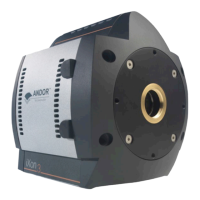Page 63
4.1 - EMCCD TECHNOLOGY
4.1.1 - What is an Electron Multiplying CCD?
Current trends in photonics are placing unprecedented demands on detector technology to perform at signicantly
greaterlevelsofsensitivityand/orspeed.Electron Multiplying Charge Coupled Device (EMCCD) technology has been
designed to respond to this growing need and in turn is opening up new avenues of novel experimental design.
EMCCDtechnology,sometimesknownas“on-chipmultiplication”,isaninnovationrstintroducedtothedigital
scientic imaging community by Andor Technology in 2000, with the launch of our dedicated, high-end iXon platform of
ultra-sensitive cameras. Essentially, the EMCCD is an image sensor that is capable of detecting single photon events
without an image intensier, achievable by way of a unique electron multiplying structure built into the chip.
EM gain can be increased to a degree. It is readily adjustable in real time through the software, where extremely weak
signals may be detected above the read noise of the camera at any readout speed. This is important because the
traditional problem of combining sensitivity with speed in standard CCDs is that the two are mutually exclusive, i.e.
greater read noise detection limits result from faster pixel readout.
4.1.2 - Does EMCCD technology eliminate Read Out Noise?
System noise within modern silicon based detectors has two primary sources: dark current noise and read noise. The
higherthenoiseooronadetectorthelessableitistoreadouttheextremelyweaksignalsassociatedwithultralow
light imaging.
With thermoelectric cooling, dark current noise can be reduced to negligible levels. An EMCCDs ability to multiply weak
signalsabovethedetector’sreadnoiseoor,byapplyingEMgain,effectivelyeliminatesreadnoiseatanyspeedby
reducing it to << 1 e-/p/s.
4.1.3 - How sensitive are EMCCDs?
Twoparameterssignicantlyinuencedetectorsensitivity,namelyQuantumEfciency(QE)andsystemnoise.QEis
a measure of a camera’s ability to capture valuable photons. A high QE results in more photons being converted to
photoelectrons within the CCD pixels.
Onceconverted,thephotoelectronsinagivenpixelmustovercomethedetectionlimitornoiseoorofthecamera,
which is set by the system noise. EMCCDs deliver superior sensitivity by maximizing QE and minimizing system noise,
through the unique gain control feature. Single photon events are now well within the capabilities of super sensitive
EMCCD technology.
SECTION 4 - HARDWARE
Hardware

